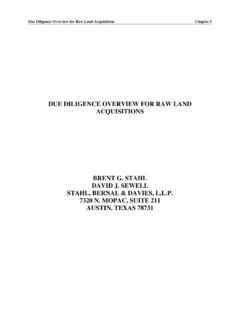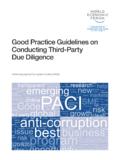Transcription of Due Diligence Report - Magellan Advisors
1 Practical Aspects Of Acquisition Due Diligence Practical Aspects Of Acquisition Due Diligence By Richard P. Mager, CPA. Magellan Advisors , Inc. 630-541-5307. What is due Diligence ? An investor performs due Diligence on a targeted acquisition to understand and evaluate the business entity prior to closing the deal. It's like inspecting a house before closing. There are two types of due Diligence : acquisition due Diligence is what a buyer performs on a seller to evaluate a potential investment; internal due Diligence is what company management does to run the business effectively. We're concerned with the former. From a technical standpoint, acquisition due Diligence is defined as the analytic review and validation of business operations and financial position performed by a buyer to substantiate valuation, assess operational performance and identify misrepresentations.
2 In layman's terms, acquisition due Diligence is avoiding surprises. It's important that due Diligence be planned, structured and focused on the key elements. Otherwise, the process can drift aimlessly wasting time and resources. Many, if not most, published due Diligence programs deal with internal due Diligence procedures which can be confusing to someone trying to buy a business. Internal due Diligence is to a large extent an audit process where unrestricted access to given to operating systems, source documents and employees. On the other hand, acquisition due Diligence is usually conducted under restricted conditions because the seller wants to maintain confidentiality of the pending sale. Having strange people come in asking questions and examining accounting records is sure to tip off the seller's workforce that something is happening.
3 Therefore, acquisition due Diligence will likely be performed from a hotel room with the seller's CEO. and CFO serving as the contacts and conduits. The seller may also employ one or more intermediaries to facilitate communications with the buyer. 1. Copyright 2006 Magellan Advisors , Inc. Practical Aspects Of Acquisition Due Diligence An effective cover for on-site due Diligence work is having the seller go through the motions of preparing a business plan for the purpose of obtaining financing. This provides justification for the presence of an intermediary because the information gathered for initial due Diligence and loan document preparation is essentially identical. Acquisition due Diligence can be divided into two phases. Phase 1, initial due Diligence , is a top-level, kick-the-tires evaluation that provides the visibility to reject an acquisition if it does not satisfy basic investment criteria.
4 Phase 2, secondary due Diligence , is a more intense evaluation that drills deeper into operations. What are the specific objectives of Phase 1 due Diligence ? The ultimate goal of Phase 1 is to determine whether or not to proceed with Phase 2. Keep in mind that conducting due Diligence requires expensive resources: a smart buyer knows when to abandon a potential investment. Phase 1 also provides focus for the subsequent evaluation during Phase 2. Successful completion of Phase 1 due Diligence will provide insight into five key areas that are crucial to early acquisition evaluation: Entity structure Historical financial performance Business model Going concern validation Impairments Entity structure An entity review focuses on ownership and legal status. Specific areas to look at here include the following: Shareholders Officers and directors Corporate status Divestiture covenants Licensing and permits UCC encumbrances 2.
5 Copyright 2006 Magellan Advisors , Inc. Practical Aspects Of Acquisition Due Diligence Historical financial performance Operating results for prior years may not be indicative of future performance, but it's the starting point for financial analysis. Historical financial data should be normalized to eliminate anomalies, discretionary transactions and extraordinary items. Although tax returns represent official information, these documents lack the detail for trend and ratio analysis. Internal financial statements by department and product line are the basis for in-depth analysis. Audited financial statements are preferred, but most of the smaller, closely-held companies do not conduct formal independent audits. Special attention should be given to unrecorded liabilities, impaired assets and accounting methods that deviate from generally accepted accounting principles.
6 Business model The business model defines the who, what and how of operations. Specific questions that need to be answered are: How does the company generate revenue? How does the company distribute products and services? What are the primary markets? Who are the primary customers? Who are the primary competitors? What technology does the company rely on? What resources does the company consume to generate revenue? What are the inherent business risks? Going concern validation A business is a going concern if it has the ability to continue functioning as a business entity for a foreseeable future period. Specifically, the business must be able to pay its liabilities when they become due, and it must have the intention to keep its assets in place to contribute to future operations rather than liquidating the assets for their standalone value.
7 For a business to qualify as a going concern, it must essentially satisfy all of the following conditions: 1. The business must have the legal authorization to exist as a business entity. 3. Copyright 2006 Magellan Advisors , Inc. Practical Aspects Of Acquisition Due Diligence 2. The business must have adequate working capital. 3. The business must have a saleable product or other means to continue to generate adequate revenue. 4. The business must have the means to replenish the tangible and intangible resources required to produce its products and provide its services. 5. The business must have the means to physically deliver its products and services to its customers. 6. The business must have adequate business insurance to safeguard its assets. 7. The business must have a functional accounting system to measure performance on an ongoing basis and to maintain internal control.
8 8. The business must not be involved in litigation or administrative action that may drain its assets or otherwise prevent it from continuing its operations. Impairments An impairment is an existing or potential situation or condition that may adversely affect business operations or financial position. The presence of only one significant impairment may be sufficient to reject a targeted acquisition or justify a heavily discounted purchase price. Impairments need to be identified as early as possible during the due Diligence process. Impairments fall into three categories. Category 1 impairments are those that the seller discloses or that can be readily identified from financial statements or other operational sources. Erosion of revenue is an example of a Category 1 impairment. Category 2 impairments are those that the seller is aware of but refuses to disclosed for any number of reasons.
9 An example is pending litigation that the seller hopes will never happen. Category 3 impairments are those that the seller is not aware of. The acid test of the due Diligence process is its ability to identify Category 2 and Category 3 impairments. An effective tool in this regard is a properly drafted Management Representation Letter signed by the 4. Copyright 2006 Magellan Advisors , Inc. Practical Aspects Of Acquisition Due Diligence seller's CEO and CFO. Letters should be executed at the start of the due Diligence review. Some of the high exposure issues that due Diligence should be structured to uncover include: employee discrimination, sexual harassment, workplace hazards, environmental pollution, defective products, delinquent taxes, patent infringement, breach of contract or covenants, inadequate insurance, unrecorded liabilities and defective or obsolete assets.
10 Documents to request for Phase 1 due Diligence List of ownership Organization chart Articles of Incorporation By-laws Catalogs List of major customers List of major competitors Loan agreements Federal tax returns last 5 years Internal financial statements last 5 years and current Accountants' reports last 5 years Operations reports last 12 months Business plan Due Diligence checklist I. Corporate A. Entity structure B. Ownership C. Government compliance D. Litigation II. Administrative A. Information systems B. Internal control C. Credit & collections D. Cash management E. Strategic planning 5. Copyright 2006 Magellan Advisors , Inc. Practical Aspects Of Acquisition Due Diligence F. Risk management G. Records retention III. Financial A. Historical performance B. Financial statement integrity C. Accounting policies & procedures D.







